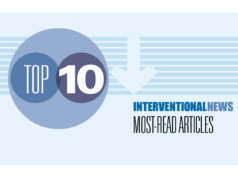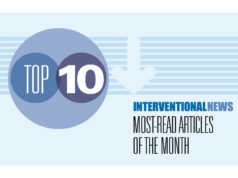 Our top 10 stories of January 2021: musings on ethical decision-making during the COVID-19 pandemic, a reflection on the status and future of paediatric interventional radiology, further developments in the ongoing discussion concerning paclitaxel-device use in the peripheral arteries, the future of radioembolization, and new device indications.
Our top 10 stories of January 2021: musings on ethical decision-making during the COVID-19 pandemic, a reflection on the status and future of paediatric interventional radiology, further developments in the ongoing discussion concerning paclitaxel-device use in the peripheral arteries, the future of radioembolization, and new device indications.
1. Paediatric interventional radiology in the spotlight: “There is still much more to be done”
In an effort to raise the profile of paediatric interventional radiology (PIR), CVIR Endovascular Editor-in-Chief Jim Reekers (Amsterdam UMC, Amsterdam, The Netherlands) invited Alex Barnacle (Great Ormond Street Hospital, London, UK) and Anne Marie Cahill (The Children’s Hospital of Philadelphia, Philadelphia, USA) to guest edit the journal’s first thematic series on the topic.
2. FDA Perspective in NEJM highlights need for continued clinical studies on paclitaxel devices
Following the publication of the SWEDEPAD interim analysis, Andrew Farb, Misti Malone, and William H Maisel, representatives of the Center for Devices and Radiological Health, US Food and Drug Administration (FDA), authored a perspective piece in the New England Journal of Medicine (NEJM), titled, “Drug-coated devices for peripheral arterial disease [PAD]”.
3. Interventional radiologists call on WHO to address the “dramatic lack of IR services” in low income countries
The European Trainee Forum of the Cardiovascular and Interventional Radiological Society of Europe (CIRSE), the Residents, Fellows, and Students section of the Society of Interventional Radiology (SIR), the Society of African Interventional Radiology & Endovascular Therapy (SAFIRE), and Road2IR—a collaborative effort between several partner institutions aiming to build self-sustaining interventional radiology (IR) training programmes in East Africa—published an open letter to the World Health Organisation (WHO) this month in CVIR Endovascular, calling for an increase in the efforts to understand the needs of low income countries regarding image-guided therapies.
4. EXTRACT-PE trial data confirm Indigo Aspiration system is safe and effective for the treatment of pulmonary embolism
Data from the EXRACT-PE trial, published online first in the Journal of the American College of Cardiology (JACC): Cardiovascular Interventions, found that the Indigo Aspiration system (Penumbra) met its predefined safety and efficacy endpoints for the treatment of pulmonary embolism (PE). In this multicentre, prospective study, the Indigo aspiration system was associated with a significant reduction in the right ventricular-to-left ventricular (RV/LV) ratio and a low major adverse event rate in submassive PE patients. Intraprocedural thrombolytic drugs were avoided in 98.3% of patients.
5. VasQ device improves AVF creation in haemodialysis patients, JVA study reports
VasQ, a high haemocompatibility biosynthetic vascular device from Laminate Medical Technologies, could be protective against the haemodynamic modifications that occur during arteriovenous fistulae (AVF) creation, a recent article in The Journal of Vascular Access reports. Roberto Palumbo (Saint Eugenio Hospital, Rome, Italy) and co-authors caution that their results, which derive from their clinical experience and are thus representative of a “real-life setting”, should be considered preliminary. They call for further research of the VasQ device in AVF creation, and say that “further effective treatments are needed to prevent or treat AVF failure”.
6. Personalised treatment planning “the future” of radioembolization, ECIO hears, in Y-90 vs. Ho-166 comparison
Personalised treatment selection and planning based on controlled dosimetry will lead to improvements in treatment accuracy. This is the conclusion presented by Marnix Lam (University Medical Center Utrecht, Utrecht, The Netherlands) at ECIO Virtual (27 January, online), a series of afternoon webinars that the Cardiovascular and Interventional Radiological Society of Europe (CIRSE) is hosting in lieu of the 2020 European Conference on Interventional Oncology (ECIO). Lam spoke on the differences between Yttrium-90 (Y-90) and Holmium-166 (Ho-166) radioembolization, and told delegates that it was “very important” to ensure interventionalists conduct a “good” scout procedure with control over selection and planning.
7. FDA approves MicroVention’s lower-profile WEB 17 intrasaccular aneurysm treatment device
The US Food and Drug Administration (FDA) has granted premarket approval (PMA) for the Woven EndoBridge (WEB) 17 system from MicroVention, a US-based subsidiary of Terumo. This is a new addition to the WEB aneurysm embolization system for the treatment of intracranial wide-neck bifurcation aneurysms.
8. FDA grants breakthrough device designation to PEDRA Xauron real-time tissue perfusion system
The US Food and Drug Administration (FDA) has granted Pedra Technology a breakthrough device designation for the periprocedural use of the company’s Pedra Xauron perfusion system in the treatment of critical limb-threatening ischaemia (CLTI).
9. Thinking about ethics during the COVID-19 pandemic: Insights and practical approaches for interventional radiologists
“Practicing ethical inquiry and reflection may mitigate the moral distress that can arise from ethical dilemmas,” write Michelle Shnayder-Adams, Eric J Keller, and Mina S Makary—and there have certainly been a number of emotionally-challenging ethical dilemmas for healthcare providers treating patients against the backdrop of the COVID-19 pandemic. The authors of this opinion piece discuss the intersection of medical ethics and interventional radiology (IR) amidst this crisis, and propose a framework interventionalists can use to enable decision-making when faced with multiple, conflicting moral obligations, which they say can cause stress and uncertainty.
10. LINC 2021 first time data releases in arteriovenous access: Positive results for IN.PACT AV DCB and Ellipsys system
New data presented for the first time at LINC 2021 (The Leipzig Interventional Course; 25–29 January, online) are positive for the IN.PACT AV drug-coated balloon (DCB) and the Ellipsys vascular access system (both Medtronic). The IN.PACT AV Access study investigated the use of DCB angioplasty versus percutaneous transluminal angioplasty (PTA) for the treatment of dysfunctional arteriovenous fistulas (AVFs). In a second presentation at the virtual congress, delegates were treated to a comparison of surgically-created versus percutaneously-created AVFs.









